Welcome to the AUTOFLEX newsletter! We’re happy to provide some insights to our latest developments and results. In this issue we’ll cover the conclusion of Work Package 2 that came to an end last year, sum up our latest engagement on an international stage and we’ll introduce you to the AUTOFLEX transport system.
If you are interested in receiving the newsletter directly to your inbox, click the ribbon in the header and sign up!
Work Package 2 is Completed
From Modal Shift Barriers to Design Parameter Quantification
A new intermodal transport service will be based on safe, efficient, and fully automated connected inland shipping which requires integration into existing logistic chains. Introducing the AUTOFLEX transport system.
After one year into the project the work package ‘From modal shift to barriers to design parameters quantification’ is concluded. The findings and results of the work package are a valuable basis for the other (upcoming) tasks in the project, e.g. how to design a multi-modal transport system for the use case areas or how to make use of renewable energies for waterborne transport.
As for every transport service, both the supply and the demand side need to be considered. That is why AUTOFLEX was looking into the existing infrastructure, analysing geographic, nautical, or technical information about the envisioned use cases. This information was then combined with the existing market potential. The result of this is available in two deliverables.
D2.1 – Design Parameter and D2.2 – Market Analysis are concluding the second Work Package which was officially ending after 12 project months, i.e. in December 2024.
Both deliverables take a look at particular areas. AUTOFLEX picked two regions in Europe that are already familiar with Inland Waterway Transport (IWT) and is exploring them as dedicated Use Case areas. IWT is attractive for local and regional transport, which for most cases excludes international transport across state borders. The Netherlands and the Flanders Area of Belgium offer different perspectives and multiple options for the establishment of the AUTOFLEX transport system. Within the two countries, IWT is already established and large parts of the waterway network is already served by commercial actors. However, their focus is solely on larger waterways for vessels of CEMT class IV and above. AUTOFLEX is looking into smaller waterways like CEMT II.
AUTOFLEX Market Analysis
The market analysis looking at goods that are being transported within the Use Case areas. To assess the feasibility of shifting cargo to inland waterways, a market analysis was conducted based on statistical data following the Nomenclature of Territorial Units for Statistics (NUTS) classification of the EU. This analysis focused on transport flows within the AUTOFLEX Use Case areas, considering road and inland waterways, while excluding rail due to insufficient or unavailable data.
The study examined transport routes, flows, and volumes across different commodity groups. Key findings indicate that no single commodity type or transport mode dominates. Instead, a diverse range of goods moves across both roads and inland waterways. Three primary commodity groups account for most of the cargo in the Use Case areas: agricultural products, building materials, and miscellaneous goods. The latter category is particularly relevant for AUTOFLEX, as it includes containerised cargo, which is assumed to represent a significant share of total transport volume. Strong cargo flows of miscellaneous goods to and from the Port of Rotterdam and a balanced split between road and inland waterways indicate containerised cargo too.
Despite the opportunity, the data does not support the assumption that specific commodities are inherently better suited for either transport mode. Instead, the findings emphasise that cost remains the dominant factor in mode selection, alongside considerations such as weight-volume ratio, cargo value, and time sensitivity. The study highlights the importance of offering diverse and flexible transport options to remain competitive. A modular transport concept integrating multiple modes could provide an attractive solution for investors, as it allows for greater adaptability to market demands while reducing reliance on specific infrastructure. This reinforces the potential for AUTOFLEX solutions both within and beyond the Use Case areas.
AUTOFLEX Design Parameter
Another central objective within the work package was to create an extensive overview on requirements and framework conditions which need to be considered in the further process of designing the AUTOFLEX transport system. This includes mainly the inland waterways themselves with detailed information on fairway parameters for efficient sailing, berths and transshipment points for vessel and cargo handling, and locks, weirs, bridges as well as overhead structures crossing or blocking the inland waterway. Another important factor is a synopsis of the existing (waterborne) transport services. Including potential consignors, such as production units and distribution centres, and the existing inland waterway infrastructure.
The geographic design parameters or in the following referred to as points of interest are one of the key results from the work package. The analysis is based on data coming from national authorities, such as Rijkswaterstaat or De Vlaamse Waterweg, and the online platform EuRIS.
Several facts and findings about the two use case areas have confirmed a high potential for the implementation of the envisioned AUTOFLEX transport system. Both countries are traversed by a dense inland waterway network, featuring a considerable share of small inland waterways of CEMT classes I to IV. The networks are not only connected to each other. There is as well a good connection with neighbouring networks, such as the Wallonian waterways, the French waterways, the West German Canal network and Europe’s busiest inland waterway, the Rhine and the Rhine-Alpine Corridor. Moreover, the two countries feature high economic activity and, thereby, potential for domestic and regional waterborne transport. With a large number of operators (and other members of the respective IWT ecosystems) who already operate on the larger waterways of both countries, AUTOFLEX is assuming a high potential for operation expansion to the smaller waterways with smaller inland vessels once proven they’re technically feasible and economically viable.
[ Download D2.1 – Design Parameter](https://autoflex-vessel.eu/wp-content/uploads/2025/01/AUTOFLEX_D2.1_Design-Basis.pdf “AUTOFLEX Deliverable D2.1 for PDF Download”)
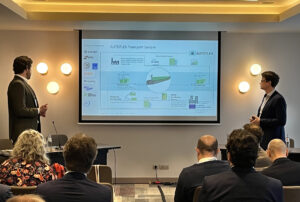
Waterborne Days 2025
The Waterborne Days 2025 conference provided a dynamic platform for networking and discussions on the future of sustainable and digital waterborne transport. Among the 13 EU-funded projects represented at the event, AUTOFLEX made an impression during its journey toward shaping the future of flexible and automated waterborne transport.
For AUTOFLEX, this international stage was a great opportunity for visibility, allowing the project to engage with key stakeholders from the European waterborne sector and other EU-funded projects that are ongoing. One of the highlights was the first-ever presentation of the AUTOFLEX roll-up banner, which visually captured the project’s core concepts. The banner prominently displayed the four building blocks of AUTOFLEX, each represented by a unique icon, symbolising the project’s innovative approach.
Situated in a room dedicated to fellow research projects, AUTOFLEX was in excellent company, standing alongside EU-funded research initiatives in the sector. The event emphasised collaboration and knowledge exchange, reinforcing the importance of a collective approach to tackling challenges in waterborne transport.
Spotlight on AUTOFLEX
On the second day of the conference, AUTOFLEX took center stage in the ‘Projects in the Spotlight’ session. Together with other cutting-edge projects—including HealthyShip4U, CirclesOfLife, DynaPort, and MISSION— AUTOFLEX representatives provided an overview of the project’s scope, objectives, and partnerships. The session was a key moment to highlight the latest advances in research and innovation, offering insights into how AUTOFLEX contributes to a more sustainable, efficient, and automated waterborne transport system.
The interactive session also allowed project representatives to engage with the audience, answering questions and discussing the impact of their research. This exchange of ideas reinforced AUTOFLEX’s commitment to bridging the gap between innovation and real-world application in the maritime sector.
AUTOFLEX extends its gratitude to the organisers of Waterborne Days 2025 for hosting the event. The conference provided a great platform for collaboration and knowledge exchange, bringing together industry leaders, researchers, and policymakers to shape the future of waterborne transport.
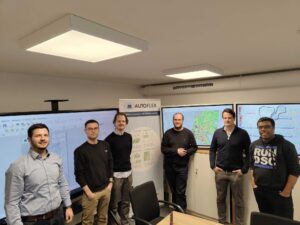
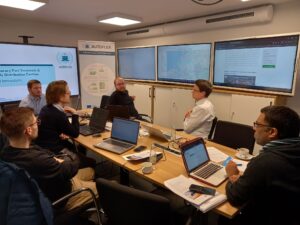
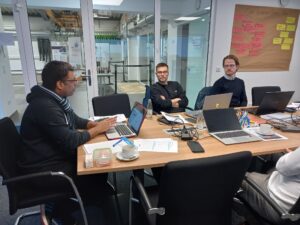
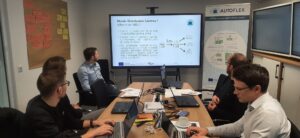
Transport System
Work Package 3
What will the AUTOFLEX Transport System look like and what elements are needed for a sustainable implementation?
All this was discussed in detail by members of the AUTOFLEX consortium. Although people from AUTOFLEX value the advantages of online meetings and are efficiently working together across different European countries, there is an upside to in-person meetings you cannot reproduce with a camera and a microphone. That is why on February 6th a dedicated Work Package 3 meeting assembled key persons to discuss the implementation of the AUTOFLEX building blocks in possible micro scenarios.
Based on findings from the second work package and substantiell data the group discussed where and how to place Stow & Charge terminals or Temporary Port Terminals within the Use Case area, investigated for potential stakeholders how they could benefit from cargo transport on small waterways and how to design effective Mobile Distribution Centres for last-mile delivery. The AUTOFLEX building blocks will be defined in detail within Work Package 3 that is still ongoing. Concepts of the TPT, S&C and MDC will be conceptualised throughout the year and will be published before Christmas in the upcoming deliverable ‘Transport concepts’.